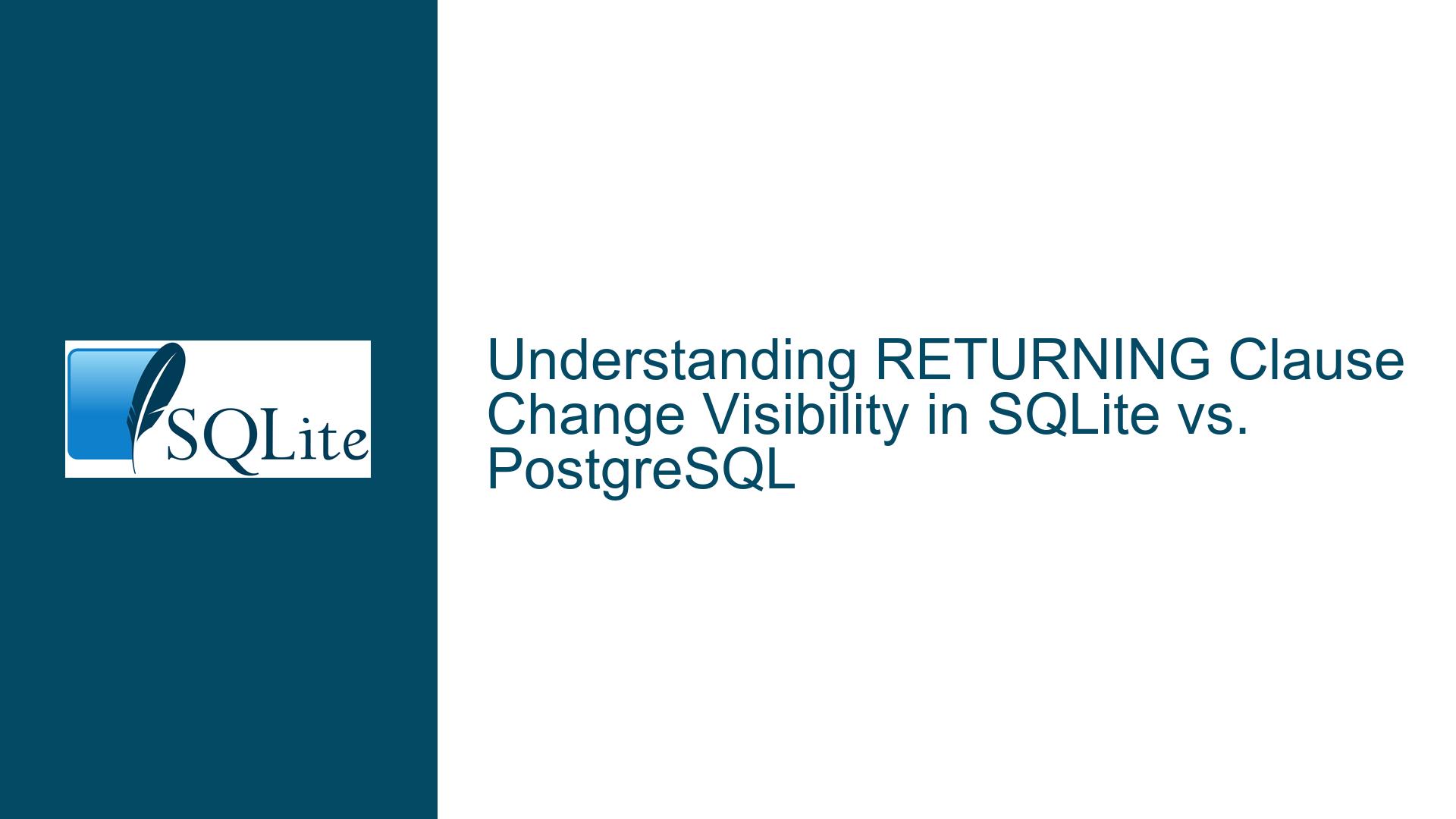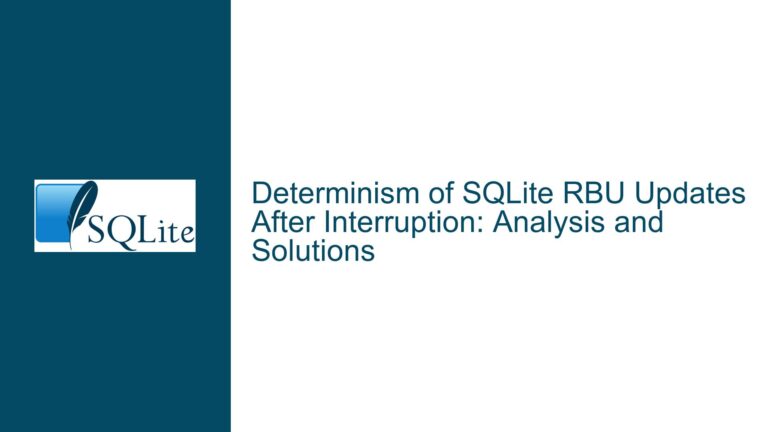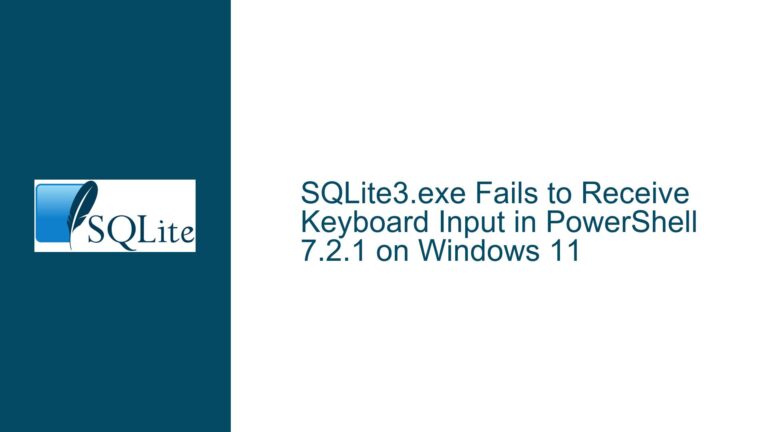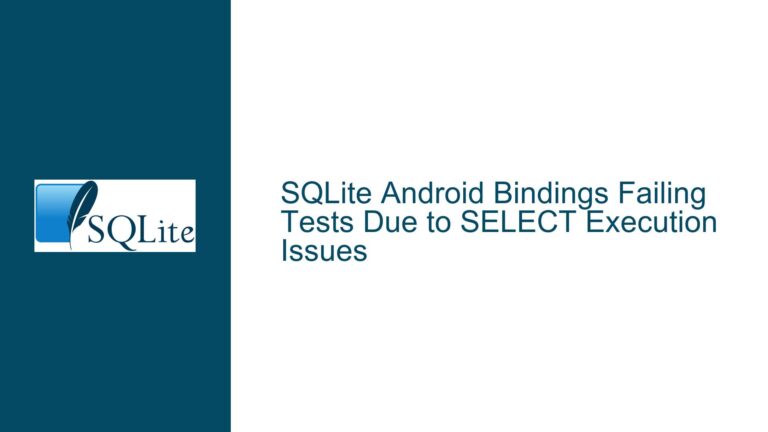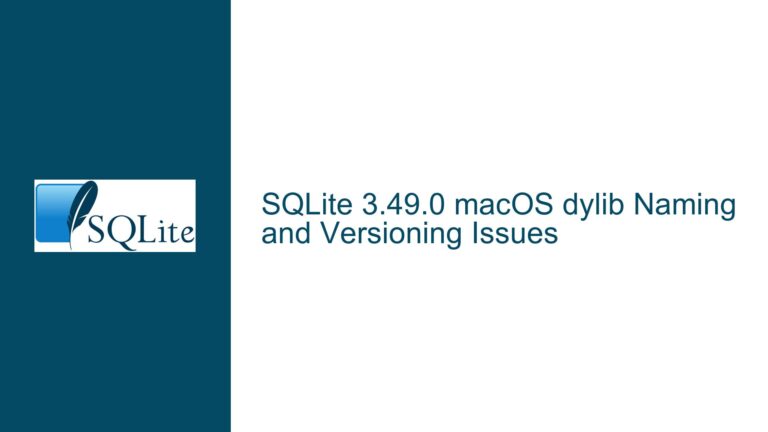RETURNING Clause Change Visibility in SQLite vs. PostgreSQL
Divergence in RETURNING Clause Behavior Between SQLite and PostgreSQL
The RETURNING clause in SQLite and PostgreSQL allows developers to retrieve modified rows directly from INSERT, UPDATE, or DELETE statements. While SQLite historically modeled this feature after PostgreSQL, recent changes in SQLite’s implementation have introduced critical differences in how these databases handle visibility of changes during RETURNING clause execution.
In SQLite versions prior to the 2024-04-25 update, the RETURNING clause operated under a "bulk modification first, output collection second" paradigm. All database changes for the statement were applied first, and the RETURNING clause collected results from the post-modification database state. This mirrored PostgreSQL’s behavior superficially but contained subtle bugs in edge cases involving triggers, virtual tables, or nested queries. The updated implementation processes each row modification individually, with the RETURNING clause executing immediately after each row change while subsequent rows remain unmodified. This creates different visibility semantics compared to PostgreSQL, where RETURNING clause expressions evaluate against the database state before any modifications from the containing statement.
The critical divergence lies in three areas:
- Timing of expression evaluation: SQLite now evaluates RETURNING expressions per-row during modification, while PostgreSQL uses pre-modification values
- Visibility of prior modifications: SQLite’s RETURNING clause sees changes from earlier rows in the same statement, whereas PostgreSQL’s does not
- Transaction isolation: SQLite’s approach creates different atomicity characteristics for bulk operations with RETURNING clauses
Consider this example with a table accounts(balance) containing rows (100), (200):
-- SQLite (new behavior)
UPDATE accounts
SET balance = balance * 2
RETURNING (SELECT SUM(balance) FROM accounts);
The RETURNING subquery will return 200 (first row modified) + 200 (second row unmodified) = 400 after processing the first row, then 200 + 400 = 600 after the second row. PostgreSQL would return 300 (original sum) for both rows because it calculates the subquery against the pre-update state.
This behavioral divergence impacts applications that:
- Use RETURNING with aggregate functions or subqueries
- Implement audit logging via RETURNING
- Rely on cross-row consistency during batch updates
- Utilize triggers that modify other tables
The documentation ambiguity stems from SQLite’s description of RETURNING output being "accumulated in memory" during the first sqlite3_step() call. This phrasing leaves room for interpretation about whether accumulation happens incrementally (per-row) or batched (post-modification). PostgreSQL’s documentation explicitly states RETURNING expressions see the database state before the command, creating a clear expectation that SQLite’s documentation does not fully address.
Root Causes of Visibility Discrepancies in RETURNING Output
The divergence in RETURNING clause behavior originates from fundamental differences in how SQLite and PostgreSQL approach query execution and transaction management. SQLite’s architecture as an embedded database with minimal concurrency requirements allows optimizations that would be untenable in PostgreSQL’s client-server model with multi-version concurrency control (MVCC).
1. Row-Level vs Statement-Level Atomicity
SQLite implements atomic commits at the statement level by default. When executing an UPDATE statement affecting multiple rows, all changes occur within a single implicit transaction. The new RETURNING processing model aligns with this by making each row modification immediately visible to subsequent RETURNING calculations for the same statement. PostgreSQL maintains strict statement-level atomicity but uses MVCC snapshots to ensure all RETURNING expressions see identical pre-modification states, regardless of the number of rows modified.
2. Virtual Machine Instruction Pipeline
SQLite compiles SQL statements into a bytecode program executed by its virtual machine. The old RETURNING implementation queued all row modifications first, then processed RETURNING as a separate phase. The revised approach interleaves modification and RETURNING bytecode operations. This pipeline optimization improves memory usage for large batches but alters visibility semantics. PostgreSQL’s executor processes RETURNING projections through a separate plan node that pulls from the modify node’s output, maintaining pre-modification visibility.
3. Subquery Evaluation Context
When a RETURNING clause contains subqueries, SQLite evaluates them in the context of the current database connection state after any prior row modifications from the same statement. PostgreSQL evaluates such subqueries against the snapshot taken at statement start. This difference becomes apparent in scenarios like:
-- Table: items(id, stock)
INSERT INTO items(stock)
VALUES (100), (200)
RETURNING (SELECT AVG(stock) FROM items);
In SQLite, the first RETURNING row would calculate (100)/1 = 100, the second would calculate (100+200)/2 = 150. PostgreSQL would return NULL for both rows if the table was initially empty, as the INSERT hasn’t committed yet.
4. Trigger Interaction
SQLite triggers fired by row modifications can alter tables that subsequent RETURNING subqueries access. Consider:
CREATE TABLE audit(log TEXT);
CREATE TRIGGER log_update AFTER UPDATE ON accounts
BEGIN
INSERT INTO audit VALUES ('Updated: ' || old.balance || ' -> ' || new.balance);
END;
UPDATE accounts SET balance = balance * 2 RETURNING (SELECT COUNT(*) FROM audit);
In SQLite, each RETURNING row sees the audit entries created by prior trigger invocations. PostgreSQL would show zero because the audit inserts occur in a separate transaction visible only after statement completion.
5. Index Maintenance Timing
SQLite updates indexes immediately after each row modification. RETURNING clauses querying via indexes will see the latest index state, including changes from earlier rows. PostgreSQL’s MVCC approach ensures indexes reflect only pre-statement states during RETURNING evaluation. This affects queries like:
UPDATE accounts SET balance = 0 WHERE balance > 150
RETURNING (SELECT id FROM accounts WHERE balance = 0 ORDER BY id LIMIT 1);
In SQLite, the subquery might return IDs from previously updated rows. PostgreSQL would return no results because the index scan uses the pre-update snapshot.
6. Application Compatibility Expectations
Developers migrating from PostgreSQL often assume RETURNING semantics match exactly. When SQLite’s implementation deviates for performance or simplicity reasons, it creates subtle bugs. The recent change exacerbated this by altering existing SQLite behavior rather than just diverging from PostgreSQL. Applications relying on the old "all modifications first" approach broke when upgrading SQLite versions.
Resolving Ambiguity in RETURNING Clause Processing and Compatibility
To address visibility discrepancies and documentation ambiguity, developers must adopt strategies that account for SQLite’s unique RETURNING clause behavior while maintaining compatibility with PostgreSQL where required.
Step 1: Audit Existing RETURNING Clause Usage
Identify all queries using RETURNING with:
- Subqueries referencing the modified table
- Aggregate functions over multiple rows
- Joins to other tables that might be modified by triggers
- Applications that consume RETURNING output for subsequent database operations
For each case, determine whether the logic assumes PostgreSQL-style pre-modification visibility or SQLite’s new per-modification visibility.
Step 2: Version-Specific Query Adjustment
For applications supporting multiple SQLite versions, use runtime version checks:
if sqlite_version >= (3, 45, 0): # Hypothetical version with new behavior
run_updated_query()
else:
run_legacy_query()
Rewrite queries needing PostgreSQL compatibility using temporary tables:
-- Emulate PostgreSQL's pre-modification visibility
CREATE TEMP TABLE pre_update AS SELECT * FROM accounts WHERE balance > 150;
UPDATE accounts
SET balance = 0
WHERE balance > 150
RETURNING (SELECT id FROM pre_update WHERE id = accounts.id);
Step 3: Transaction Isolation Control
Wrap statements in explicit transactions to control visibility:
BEGIN;
-- Prevent other connections from seeing partial changes
UPDATE accounts SET balance = balance * 2;
-- Now collect results from post-update state
SELECT * FROM accounts;
COMMIT;
For PostgreSQL compatibility, use CTEs to capture pre-update states:
WITH old_values AS (
SELECT * FROM accounts WHERE balance > 100
)
UPDATE accounts
SET balance = 0
RETURNING (SELECT SUM(balance) FROM old_values);
Step 4: Trigger and Index Behavior Mitigation
Disable triggers during modifications if they conflict with RETURNING logic:
PRAGMA defer_foreign_keys = 1; -- Also affects trigger execution order
Create covering indexes to prevent index update interference:
CREATE INDEX idx_cvr ON accounts(id) WHERE balance = 0;
This maintains a stable view of qualifying rows during RETURNING clause execution.
Step 5: Documentation-Driven Query Refactoring
Align queries with SQLite’s documented processing order:
"All database changes occur during the first sqlite3_step() call. RETURNING output is accumulated during this same step."
Interpret this as:
- Each row modification is immediately followed by RETURNING processing for that row
- Subsequent rows see changes from prior rows in the same statement
Refactor queries expecting batched visibility:
-- Original (assumes all balances doubled before SUM)
UPDATE accounts SET balance = balance * 2
RETURNING (SELECT SUM(balance) FROM accounts);
-- Revised (capture post-update sum separately)
WITH updated AS (
UPDATE accounts SET balance = balance * 2
RETURNING id, balance
)
SELECT SUM(balance) FROM updated;
Step 6: Testing with Visibility Diagnostics
Implement test cases that validate RETURNING output against both SQLite and PostgreSQL:
-- Test setup
CREATE TABLE test(id INTEGER PRIMARY KEY, val INTEGER);
INSERT INTO test(val) VALUES (1), (2);
-- Visibility diagnostic query
UPDATE test
SET val = val * 10
RETURNING
val,
(SELECT SUM(val) FROM test) AS current_sum,
(SELECT SUM(val) FROM test WHERE val < 10) AS pre_update_sum;
SQLite will output:
(10, 10, 1),
(20, 30, 1)
PostgreSQL will output:
(10, 3, 3),
(20, 3, 3)
This clearly demonstrates the visibility differences.
Step 7: Leverage SQLite’s EXPLAIN
Use the EXPLAIN command to analyze how RETURNING clauses interact with modifications:
EXPLAIN UPDATE accounts SET balance = 0 RETURNING id;
Look for opcodes like:
OpenWrite(modification)ResultRow(RETURNING output)
Verify that modification and output operations alternate per row rather than being grouped.
Step 8: Migration Pathways for Existing Systems
For systems relying on the old SQLite behavior, consider these migration options:
- Version Pinning: Lock SQLite to versions before the RETURNING change
- Schema Decoupling: Move RETURNING logic to application code using separate SELECTs
- Shim Layer: Intercept RETURNING queries and rewrite them using temporary tables
def pg_compatible_returning(query):
if ' RETURNING ' in query:
# Replace with SELECT after modification
modified_query = f"""
WITH updated AS ({query.replace(' RETURNING ', ' ')})
SELECT * FROM updated;
"""
return modified_query
return query
Step 9: Documentation Enhancements
Clarify application behavior by augmenting SQLite’s documentation with:
**RETURNING Processing Nuances**
- Expressions in RETURNING see changes from prior row modifications
- Subqueries execute against the current database state, not a statement snapshot
- Use CTEs with synthetic tables to capture pre-modification states
Step 10: Community Feedback Integration
Engage with SQLite’s development team via forums to:
- Advocate for clearer documentation phrasing
- Propose compatibility flags like
PRAGMA returning_visibility=POSTGRES - Contribute test cases that validate edge-case behaviors
By systematically addressing visibility differences through query restructuring, transaction control, and diagnostic testing, developers can harness SQLite’s RETURNING clause effectively while maintaining awareness of its PostgreSQL-inspired but distinct behavior. The key lies in treating RETURNING output as an incremental stream of changes rather than a consolidated view of post-modification state.
